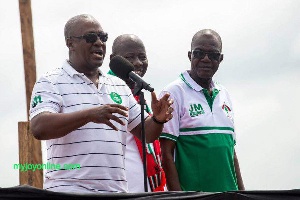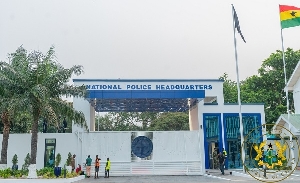“The 1992 Constitution of the Republic of Ghana that came into effect on January 7, 1993, provides the basic charter for the country's fourth attempt at republican democratic government since independence in 1957.
“It declares Ghana to be a unitary republic with sovereignty residing in the Ghanaian people. Drawn up with the intent of preventing future coups, dictatorial government, and one-party states, it is designed to foster tolerance and the concept of power-sharing.
“The document reflects the lessons drawn from the abrogated constitutions of 1957, 1960, 1969, and 1979, and it incorporates provisions and institutions drawn from British and United States constitutional models.
“The 1992 constitution, as the supreme law of the land, provides for the sharing of powers among a president, a parliament, a cabinet, a Council of State, and an independent judiciary” (U.S Library of Congress).
Apparently, Ghana’s Fourth Republic is 288 months old. And, the day-to-day management of the country within that time frame had been the responsibility of the National Democratic Congress (NDC) Party, whose share of the governance is 192 months and the New Patriotic Party (NPP), who had also governed the country for 96 months.
However, the series grub into the NDC’s last 96 months infrastructural projects-focused administration.
Prolegomenon
When former President J. J. Rawlings had completed his 96 months democratic rule in 2000, he sat back as directed by the Ghana’s 1992 Constitution. Thus, the stage was set for other qualified people to take over the presidential seat.
Even though a sizeable number of political parties presented their candidates for the hot seat, the race for the next president was keenly contested between the NDC candidate, the late John Evans Atta Mills and the NPP candidate, John Agyekum Kufuor.
The election travelled into the second round and John Agyekum Kufuor emerged victorious on 28 December 2000.
The President elect, John Agyekum Kufuor took over the presidency from former President J. J. Rawlings on 7th January 2001.
Unfortunately, President Kufuor had no honey moon as there was not much left in the coffers to plan anything meaningful. Former President J. J. Rawlings’s 228 months (military, 132 months and democratic, 96 months) administrations only managed to destabilise Ghana’s micro economic indicators.
Expedient measures
Ghana was then declared as Highly Indebted Poor Country (HIPC). The newly elected President Kufuor had a tough decision to make, by either embracing or rejecting the HIPC status. Nevertheless, the forward thinking President Kufuor chose to swallow a bitter pill with a view to getting over the malaise. He thus pragmatically embraced the HIPC status in 2001.
As a matter of fact and observation, the returns of the HIPC were unprecedented during former President Kufuor’s administration, from (2001-2008).
The fact of the matter is that microeconomic indicators begun to stabilize and Ghana’s debt stock was significantly reduced by about $4 billion within that period.
Besides, , as a result of the HIPC initiative and prudent borrowing, Ghana’s external debt stock actually declined from $6.1 billion in 2000 to$3.8 billion by 2008 (it was “unprecedented” achievement).
It is also worth stressing that the average GDP growth of the NDC from 1993-2000 was 3.8% while that of the NPP from 2001-2008 was5.2% with economic growth reaching 6.3% in 2007.
Former President Kufuor successfully completed his first term in office (four years), having managed to stabilise the micro economic indicators. Subsequently, the good people of Ghana gave him the mandate for another four year term following a keenly contested presidential election on 7th December 2004.
The finest accomplishments
It is an understatement to state that former President Kufuor’s pragmatic policies reaped tremendous results. Due to time and space, I will only enumerate on a few of his wonderful achievements during his tenure in office.
1. Helped moved Ghana from HIPC status to Lower Middle Income status.
2. Ghana received a debt relief of around $4 billion, spreading over 20 years period.
3. Built numerous infrastructural projects, including not less than 5 interchanges. Nonetheless President Mahama said back then that the erection of infrastructural projects is only an exercise in mediocrity.
4. Discovered oil in commercial quantities before handing over power to the late Mills (Ghana has since received over $3 billion in revenue).
5. Increased the economic growth from around 3.5 in 2001 to around 8.4 in 2008.
6. Quadrupled Ghana’s GDP to $28 billion by 2008.
7. Introduced free Maternal Care.
8. Implemented National Health Insurance Scheme.
9. Introduced Metro Transport System.
10. Implemented School Feeding Programme.
11. Introduced the National Youth Employment Programme, known as GYEEDA.
12. Implemented the Livelihood Empowerment Against Poverty.
As I hinted previously, the list of former President Kufuor’s achievements is not exhaustive; nonetheless I would not be able to list all of them at this point in time. All that I can state is that, former President Kufuor did so much to improve on Ghana’s fortunes.
President Kufuor discharged his job honourably, retired and handed the baton to the late President Mills on 7th January 2009, following his victory in the second round election on 28 December 2008.
K. Badu, UK.
Opinions of Monday, 28 November 2016
Columnist: Badu, K



















